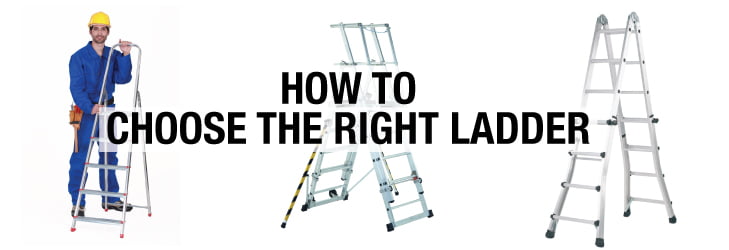How to choose the right ladder
16/09/2014

In today’s blog, we’re looking at another topic that encompasses a number of our frequently asked questions – How to choose the right ladder.
You need to consider various elements when choosing a ladder, all of which we’ll explore below:
Consider duty rating
Ladders are designed and constructed to safely hold up to a specific amount of weight. The duty rating is defined as the maximum safe load capacity of the ladder. This includes a person’s fully clothed weight plus the weight of any tools and materials that are carried onto the ladder. The total weight of these combined must be less than the duty rating.
Consider your ladder material
Are you going to be using a ladder near electricity? If so, you’ll need to pick a fibre glass step ladder perhaps. It’s the only material safe for working in and around electricity and has non-conductive side rails to keep you safe. Again, if you’re going to be working outdoors, some materials fare better than others – so do consider this when purchasing your ladder.
What are your ladder height requirements?
An extension ladder is a good choice when you need to reach several metres high. When looking for an extension ladder you’ll often have the choice of a double extension ladder and a triple extension ladder. The former is simpler and easier to use, whilst the latter is more compact and convenient to store. When it comes to their actual use though, there’s not much difference, so it’s up to you which ladder you prefer working from.
To get the approximate apex height (the highest part of the roof) you need to multiply the average ceiling height in your house by the number of floors plus one in your house. So if you have a regular 2-storey house, you’ll multiply the average ceiling height (say 2.35m) by 3. You’ll also need to add on 1.1m to this final number to allow adequate working space; this will give you the total ladder length required.
The eaves height (the part of a roof that meets or overhangs the walls of a building) can be estimated by multiplying the average ceiling height in your house by the number of floors. So if you have a regular 2-storey house, you’ll multiply the average ceiling height (say 2.35m) by 2. Again, you’ll also need to add on 1.1m to this final number to allow adequate working space; this will give you the total ladder length required.
Typically, if you live in a 2-storey home, a ladder that’s 8.15m long should meet all your requirements, and if you like in a 1-storey home, a ladder that’s 5.8m long should be suitable.
Ladders: The terminology
So you’ve written down the spec of the ladder you need, but now you’re faced with terms like closed height, extended height and working height, and have no idea what they mean…
Closed height – Length of ladder when compact
Extended height – Height of ladder when fully extended
Platform height – Height at which the platform sits on a stepladder
Working height – The safe usable working height
Reach height – Maximum height you can reach when standing on the ladder
If you have any more questions about our ladders and their usage, please do give us a call on 01282 615517 – we’d be happy to help!